At the core of GWSP’s model is a belief that first-rate research and systematic knowledge is essential to maintaining the high quality of World Bank operations. It is equally essential to shaping the external debate as part of our mission to deliver a water-secure world for all. So the GWSP produces strategic, robust and practical information, insights and ideas to shape both practice and policy.
Knowledge Highlights from the Water Global Practice 2016-2023 (updated May 2023) →
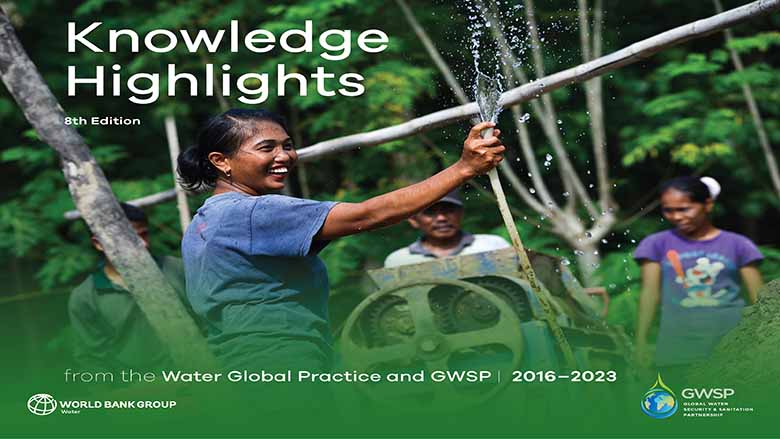
See All World Bank Publications on Water→

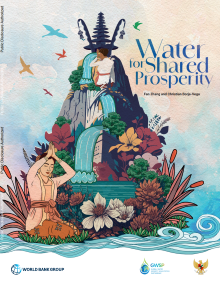 | Authors: Christian Borja-Vega; Fan Zhang Water for Shared Prosperity explores the connection between water, economic growth, and shared prosperity. It highlights the global inequalities in water access and recommends pro-poor and inclusive interventions to improve water security and strengthen climate resilience while reducing poverty and boosting shared prosperity. The World Bank’s vision of a world free of poverty on a livable planet will depend on achieving water security for all.
|
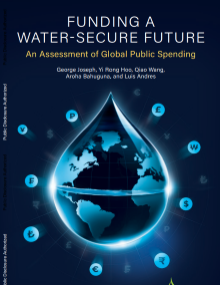 | FUNDING A WATER-SECURE FUTURE: AN ASSESSMENT OF GLOBAL PUBLIC SPENDING Authors: Joseph, George; Hoo, Yi Rong; Wang, Qiao; Bahuguna, Aroha; Andres, Luis Alberto The report quantifies for the first time how much governments spend on water and the size of the financing and funding gaps that must be closed to meet people’s needs.
|
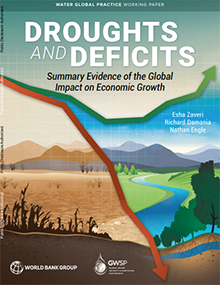 | DROUGHTS AND DEFICITS - SUMMARY EVIDENCE OF THE GLOBAL IMPACT ON ECONOMIC GROWTH Author(s): Zaveri, Damania, Engle, Lee This paper presents new estimates of the effects of dry episodes (rainfall shocks) and droughts on gross domestic product per capita growth rates using state-of-the-art empirical methods. Rainfall and water availability exhibit considerable spatial variability that is almost two times greater than that of temperature. Hence, the analysis needs to be conducted at a high degree of spatial disaggregation to capture the effects of rainfall variations on economic indicators of interest. The findings have several implications for development practitioners. They highlight the need for stewardship of forests and other natural capital that affect the hydrological cycle but are seldom associated with the growth impacts of droughts. They also highlight the need for proactive investment to address vulnerabilities through upgrades in information systems, institutions, and infrastructure that build drought resilience. |
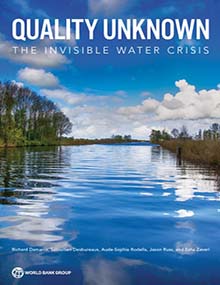 | QUALITY UNKNOWN: THE INVISIBLE WATER CRISIS Author(s):Damania, Desbureaux, Rodella, Russ, Zaveri | Focus: Water, Poverty and the Economy The report presents new evidence and new data that call urgent attention to the hidden dangers lying beneath water’s surface. It shows how poor water quality stalls economic progress, stymies human potential, and reduces food production. |
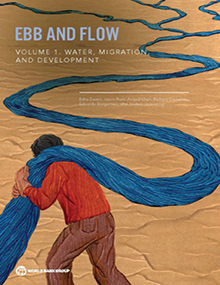 | EBB AND FLOW, VOLUME 1: WATER, MIGRATION, AND DEVELOPMENT Author(s): Zaveri, Russ, Khan, Damania, Borgomeo|Focus: Water, Poverty and the Economy The report finds that cumulative water deficits result in five times as much migration as water excess does. But there are important nuances in why and when these events lead to migration. Where there is extreme poverty and migration is costly, water deficits are more likely to trap people than induce them to migrate. |
| See All Publications on WATER and the ECONOMY→ |

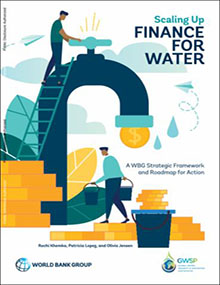 | SCALING UP FINANCE FOR WATER: A WBG STRATEGIC FRAMEWORK AND ROADMAP FOR ACTION Author(s): Rochi, Lopez, Jensen This framework provides a set of strategic directions and a customizable roadmap for the public sector, private sector, international organizations, intermediaries, and others to collaborate towards catalyzing greater financing and innovation for the water sector. This builds on the collective experience and knowledge of the World Bank and development partners on addressing the barriers to mobilizing additional resources in the sector. |
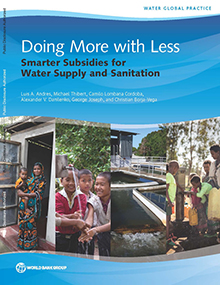
| DOING MORE WITH LESS: SMARTER SUBSIDIES FOR WATER SUPPLY AND SANITATION Author(s): Andres, Lombana Cordoba,Danilenko, Joseph, Borja-Vega | Focus: Water Supply and Sanitation This report explores how scarce public resources can be used most effectively to achieve universal delivery of water supply and sanitation services. It analyzes the prevalence and performance of subsidies in the sector, then guide policymakers on improving subsidy design and implementation to improve their efficacy and efficiency in attaining their objectives. |
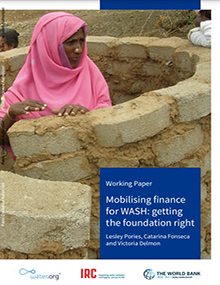
| MOBILISING FINANCE FOR WASH: GETTING THE FOUNDATION RIGHT Author(s): Pories, Fonseca, Delmon Focus: Water Supply and Sanitation Mobilising finance to address the SDG 6.1 and 6.2 financing gap successfully and sustainably will require more than innovative or sophisticated financial vehicles and mechanisms. To move to scale, private and public investment hinges on core foundational issues being addressed in the water sector by service providers, governments and other enabling environment stakeholders. This paper unpacks what is meant by the enabling environment for finance in WASH and presents real examples of how these bottlenecks are being overcome by innovators in the sector. |
| See All Publications on FINANCING→ |

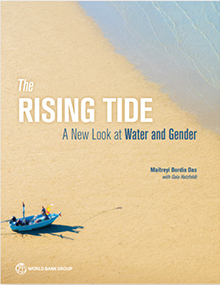 | THE RISING TIDE: A NEW LOOK AT WATER AND GENDER Author(s): Das | Focus: Social Inclusion The relationship between water and gender is important to the overall progress on water security and gender equality more broadly. This report provides a framework that shows how gender relations in water reform can influence gender equality and examines the norms and practices related to water that often exacerbate ingrained gender and other hierarchies. |
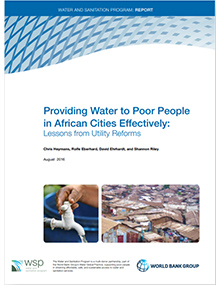 | PROVIDING WATER TO POOR PEOPLE IN AFRICAN CITIES EFFECTIVELY: LESSONS FROM UTILITY REFORMS Author(s): Heymans, Eberhard, Ehrhardt, Riley | Country: Multi-Country The cases studied show that it is possible for rapidly growing African cities to offer the poorest 40 percent of their residents near-universal access to reliable and affordable water. The technical, financial, and managerial techniques used by utilities in these cities are widely applicable. This study recognizes the achievements of cities that provide relatively good service to the poor. |
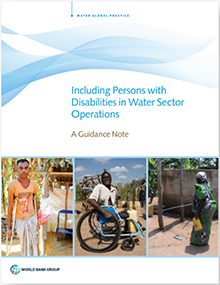 | INCLUDING PERSONS WITH DISABILITIES IN WATER SECTOR OPERATIONS: A GUIDANCE NOTE Author(s): Mcclain-Nhlapo, Raja, Sivonen, Widyastuty | Focus: Social Inclusion The ripple effects of the lack of access to water and sanitation services can have serious socioeconomic consequences for persons with disabilities and their families. This comprehensive note identifies entry points for disability-inclusive operations along with systematic and sustainable interventions in World Bank Group activities. It includes case studies, resources, examples of access barriers, and policy recommendations. |
| See All Publications on INCLUSION→ |

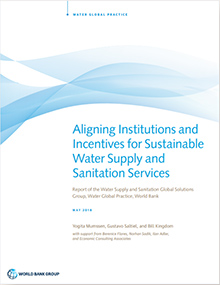
| ALIGNING INSTITUTIONS AND INCENTIVES FOR SUSTAINABLE WATER SUPPLY AND SANITATION SERVICES Author(s): Mumssen, Saltiel, Kingdom | Focus: Water Supply and Sanitation An analysis of how integrated policy, institutional, and regulatory interventions can help align incentives for more sustainable water supply and sanitation service delivery. |
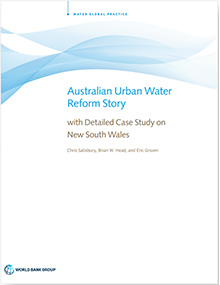
| AUSTRALIAN URBAN WATER REFORM STORY WITH DETAILED CASE STUDY ON NEW SOUTH WALES Author(s): Salisbury, Head, Brian, Groom | Focus: Water Supply and Sanitation | Country: Australia Urban water services in Australia are recognized as some of the most efficient utilities in the world, but this was not always the case. This study, carried out by the International Water Centre (IWC), looks at three decades of experience to draw out how national-level economic reforms in Australia helped transform the traditional state “build and supply” model into a modern service oriented and efficient sector. This work reveals insights around the interplay between state-level reform and regulation, and national framework agreements. |
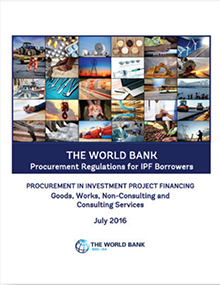
| DESIGN, BUILD, OPERATE STANDARD BIDDING DOCUMENTS Author(s): Water GP | Focus: Water Supply and Sanitation This package includes a suite of standard bidding documents for Design, Build and Operate (DBO) contracts for water and wastewater treatment plants to help simplify the contracting process. It includes the initial selection document, guidance note and a standard bidding document. |
| See All Publications on INSTITUTIONS→ |

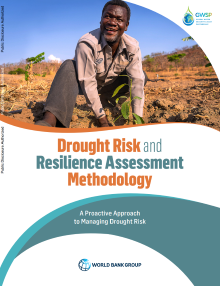 | DROUGHT RISK AND RESILIENCE ASSESSMENT METHODOLOGY: A PROACTIVE APPROACH TO MANAGING DROUGHT RISK Authors: Engle, Nathan L.; Loske-Garcia, Lara; Limones Rodriguez, Natalia. The World Bank’s Drought Risk and Resilience Assessment (DRRA) offers a structured methodology for evaluating drought risk and enhancing resilience. It is a framework for action that can help governments build resilience at every stage of the drought cycle. |
|
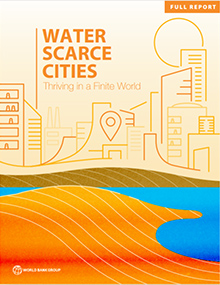 | WATER SCARCE CITIES: THRIVING IN A FINITE WORLD — FULL REPORT Author(s): World Bank | Focus: Water Security and Integrated Resource Management The report provides describes principles and approaches that cities and water utility decision makers can adopt to improve their cities’ resilience to water scarcity challenges. It is based on 20 case studies describing how cities have effectively and innovatively addressed emerging threats to their water supply security. | |
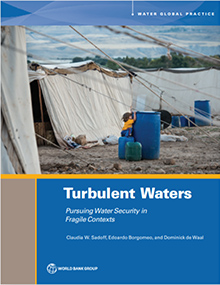 | TURBULENT WATERS: PURSUING WATER SECURITY IN FRAGILE CONTEXTS Author(s): Sadoff, Borgomeo, de Waal | Focus: Water Security and Integrated Resource Management Water insecurity can cause severe disruptions and compound fragilities in social, economic, and environmental systems. This report explores the dynamics between water insecurity and fragility and suggests that water security is more difficult to achieve in fragile contexts because of a range of factors, including weak institutions and information systems, strained human and financial resources, and degraded infrastructure. | |
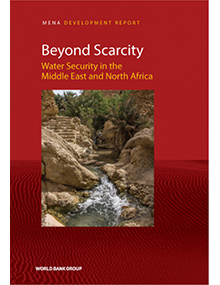 | BEYOND SCARCITY: WATER SECURITY IN THE MIDDLE EAST AND NORTH AFRICA Author(s): World Bank | Focus: Water, Poverty and the Economy Country: MENA Achieving water security in the Middle East and North Africa requires a new way of looking at water management even beyond scarcity. This report provides a regional assessment of the challenges and opportunities in the region. It examines how the resources are currently being managed and the water-related risks that need to be recognized and mitigated. | |
| See All Publications on RESILIENCE→ |

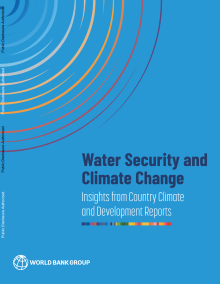 | WATER SECURITY AND CLIMATE CHANGE INSIGHTS FROM COUNTRY CLIMATE AND DEVELOPMENT REPORTS Water plays a critical role across many economic sectors and is a key pathway through which climate change impacts are felt. Understanding how the water sector is integrated into World Bank Group’s Country Climate and Development Reports (CCDRs) is essential for identifying emerging strategies that address both climate risks and development priorities. This report examines how water-related climate risks and actions are captured in CCDRs published between 2022 and 2024. |
|
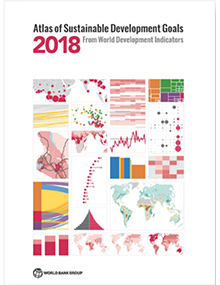 | ATLAS OF SUSTAINABLE DEVELOPMENT GOALS Author(s): World Bank The Atlas of Sustainable Development Goals 2018 is a visual guide to the trends, challenges and measurement issues related to each of the 17 Sustainable Development Goals. | |
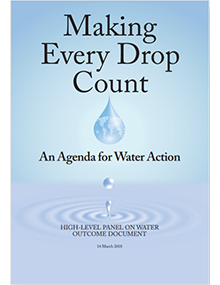 | MAKING EVERY DROP COUNT: AN AGENDA FOR WATER ACTION Author(s): High-Level Panel on Water The United Nations and World Bank Group convened a High-Level Panel on Water to provide leadership in tackling one of the world’s most pressing challenges: an approaching global water crisis. | |
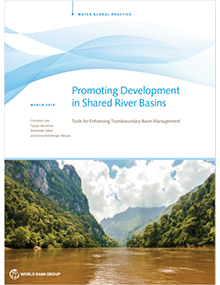 | PROMOTING DEVELOPMENT IN SHARED RIVER BASINS: TOOLS FOR ENHANCING TRANSBOUNDARY BASIN MANAGEMENT Author(s): Leb, Henshaw, Iqbal, Rehberger Bescos | Focus: Water Security and Integrated Resource Management This study identifies an array of tools derived from the international experience that can be used by countries and development partners in their efforts to develop more water secure economies and societies through harnessing the shared freshwater resources of transboundary basins, while also preventing or mitigating transboundary harm that may otherwise result. | |
| See All Publications on SUSTAINABILITY→ |

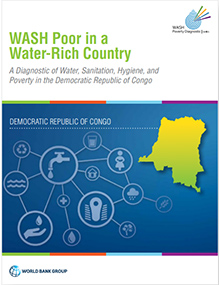 | WASH POOR IN A WATER-RICH COUNTRY: A DIAGNOSTIC OF WATER, SANITATION, HYGIENE, AND POVERTY IN THE DEMOCRATIC REPUBLIC OF CONGO ALSO AVAILABLE IN SPANISH Author(s): World Bank | Country: Democratic Republic of Congo This diagnostic analyses trends and links them to institutional weaknesses in the WASH sector, in particular institutional fragmentation, weak capacity, and a bias toward specific institutions and services. Opportunities for improvement are analyzed and condensed into six clear messages that provide guidance on the way forward for the WASH sector in the Democratic Republic of Congo. |
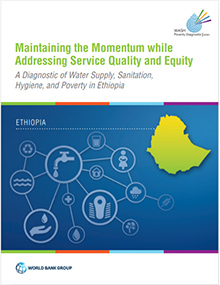 | MAINTAINING THE MOMENTUM WHILE ADDRESSING SERVICE QUALITY AND EQUITY: A DIAGNOSTIC OF WATER SUPPLY, SANITATION, HYGIENE, AND POVERTY IN ETHIOPIA Upcoming Publication | Country: Ethiopia The WASH Poverty Diagnostic Initiative captures and analyzes data from 18 countries to present evidence on inequalities in access to WASH services, examine the impact of unequal service on the poor, and explore why service delivery continues to be inadequate and inefficient in much of the world. |
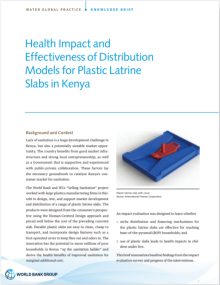 | HEALTH IMPACT AND EFFECTIVENESS OF DISTRIBUTION MODELS FOR PLASTIC LATRINE SLABS IN KENYA Author(s): Water GP | Country: Kenya Explains distribution and financing mechanisms for reaching households as well as the health impact and the effectiveness of plastic latrine slabs. |
| See All Publications on World Bank Water in AFRICA→ |

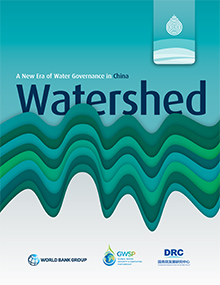 | WATERSHED: A NEW ERA OF WATER GOVERNANCE IN CHINA Upcoming Publication | Country: China In China, 28,000 rivers have disappeared over the past 25 years. In some areas, groundwater has fallen by up to 1–3 meters a year and some 110 cities face severe water shortages. Gaps also remain in basic water services coverage while water pollution imposes serious economic, ecological, and health costs. To effectively address these complex water challenges, improved approaches to water management is needed. |
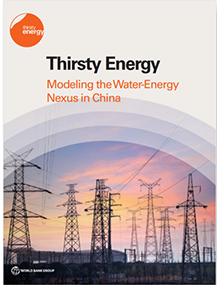 | THIRSTY ENERGY: MODELING THE WATER-ENERGY NEXUS IN CHINA Author(s): World Bank Group | Country: China To better assess the water-energy nexus challenge in China, the Thirsty Energy initiative engaged the China Institute for Water Resources (IWHR) and Hydropower Research under the auspices of the Ministry of Water Resources and the Institute of Energy, Environment, and Economy of Tsinghua University (TU) to establish a new multiregional, water-smart energy system planning model: TIMES-ChinaW. |
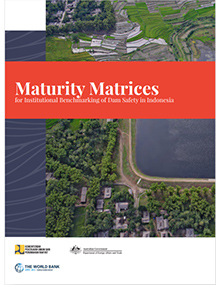 | MATURITY MATRICES FOR INSTITUTIONAL BENCHMARKING OF DAM SAFETY IN INDONESIA Author(s): World Bank Group | Country: Indonesia The development of Maturity Matrices for Institutional Benchmarking of Dam Safety in Indonesia provides a method for assessing the effectiveness of the operation, maintenance, surveillance and emergency preparedness programs adopted by dam authorities. |
| See All Publications on World Bank Water in EAST ASIA and PACIFIC→ |

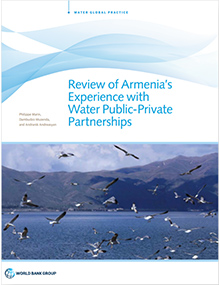 | REVIEW OF ARMENIA’S EXPERIENCE WITH WATER PUBLIC-PRIVATE PARTNERSHIP Author(s): Marin, Muzenda, Andreasyan | Country: Armenia Four water public private partnerships (PPPs) undertaken in Armenia between 2000 and 2016 and the start of a national water lease contract that began in January 2017 are studied here. |
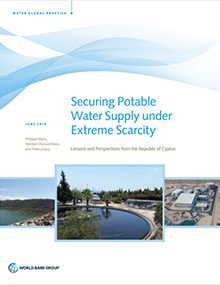 | SECURING POTABLE WATER SUPPLY UNDER EXTREME SCARCITY: LESSONS AND PERSPECTIVES FROM THE REPUBLIC OF CYPRUS Upcoming Publication | Author(s): Marin, Charalambous, Davy | Country: Cyprus Key achievements and lessons learned from the water management experience of the Republic of Cyprus for the benefit of other countries around the world facing increasing challenges in dealing with water scarcity, focusing on how potable water security was achieved. |
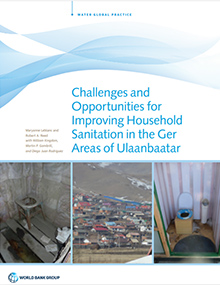 | CHALLENGES AND OPPORTUNITIES FOR IMPROVING HOUSEHOLD SANITATION IN THE GER AREAS OF ULAANBAATAR Author(s): Gambrill, Leblanc | Country: Mongolia The report identifies practicable, affordable technical options for improving household sanitation in the Ger areas of Ulaanbaatar and is aimed at assisting decision makers and other stakeholders to select the most cost-effective, feasible options for improving sanitation in the short and medium term. |
| See All Publications on World Bank Water in EUROPE and CENTRAL ASIA→ |

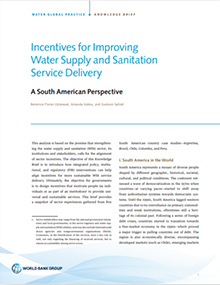 | INCENTIVES FOR IMPROVING WATER SUPPLY AND SANITATION SERVICE DELIVERY: A SOUTH AMERICAN PERSPECTIVE Author(s): Uijtewaal, Goksu, Saltiel Since 2016, the World Bank’s Water and Governance Global Practices have been implementing the Policy, Institutional and Regulatory (PIR) Incentives Initiative to gain deeper insight into the dynamics between water supply and sanitation (WSS) sector incentive mechanisms. |
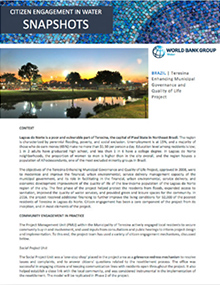 | CITIZEN ENGAGEMENT IN WATER SNAPSHOTS: TERESINA ENHANCING MUNICIPAL GOVERNANCE AND QUALITY OF LIFE PROJECT Author(s): Water GP | Country: Brazil Shows how community buy-in and involvement resulted new citizen engagement mechanisms to help expand access to sanitation, and improve water quality and access to green spaces. |
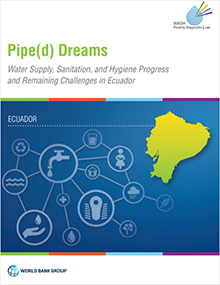 | PIPE(D) DREAMS: WATER SUPPLY, SANITATION, AND HYGIENE PROGRESS AND REMAINING CHALLENGES IN ECUADOR Author(s): World Bank | Country: Ecuador An extensive body of research assessing the extent and quality of water supply, sanitation, and hygiene (WASH) services geographically and over the income distribution. It explores the interaction between WASH outcomes and health, especially nutrition; and the institutional barriers as well as opportunities to reduce the gaps in improved access to WASH between rural and urban areas in Ecuador. |
| See All Publications on World Bank Water in LATIN AMERICA and the CARIBBEAN→ |

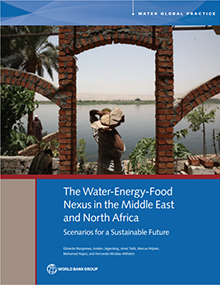 | THE WATER-ENERGY-FOOD NEXUS IN THE MIDDLE EAST AND NORTH AFRICA: SCENARIOS FOR A SUSTAINABLE FUTURE Author(s): Borgomeo, Jagerskog, Talbi, Wijnen, Hejazi, Miralles-Wilhelm Water, energy, and agriculture have been conventionally dealt with separately in investment planning. For each of these sectors, regulatory frameworks, organizations, and infrastructures have been put in place to address sector-specific challenges and demands. As the Middle East and North Africa works towards building a more sustainable future, a nexus approach that considers the risks and synergies among these sectors is needed. |
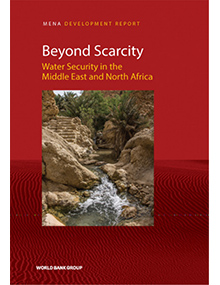 | BEYOND SCARCITY: WATER SECURITY IN THE MIDDLE EAST AND NORTH AFRICA Author(s): World Bank | Focus: Water, Poverty and the Economy Country: MENA Achieving water security in the Middle East and North Africa requires a new way of looking at water management even beyond scarcity. This report provides a regional assessment of the challenges and opportunities in the region. It examines how the resources are currently being managed and the water-related risks that need to be recognized and mitigated. |
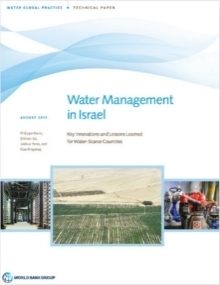 | WATER MANAGEMENT IN ISRAEL: KEY INNOVATIONS AND LESSONS LEARNED FOR WATER SCARCE COUNTRIES Author(s): Marin, Tal, Yeres, Ringskog | Country: Israel Illustrates the nine important lessons learned which are of major importance for other countries facing increasing water scarcity. |
| See All Publications on World Bank Water in MIDDLE EAST and NORTH AFRICA→ |

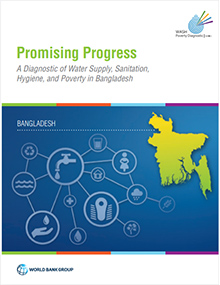 | PROMISING PROGRESS: A DIAGNOSTIC OF WATER SUPPLY, SANITATION, HYGIENE, AND POVERTY IN BANGLADESH Country: Bangladesh A snapshot of the quality and inequality of WASH access in Bangladesh, with statistics from numerous dataset. This report also attempts to show the implications of these numbers on human development and poverty reduction. |
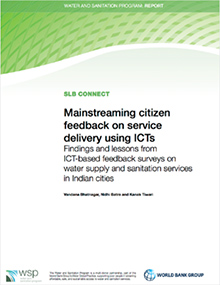 | MAINSTREAMING CITIZEN FEEDBACK ON SERVICE DELIVERY USING ICTS: FINDINGS AND LESSONS FROM ICT-BASED FEEDBACK SURVEYS ON WATER SUPPLY AND SANITATION SERVICES IN INDIAN CITIES Author(s): Bhatnagar, Batra, Tiwari | Country: India This report presents the results from implementation of Service Level Benchmarks (SLBs) to strengthen service delivery in India. |
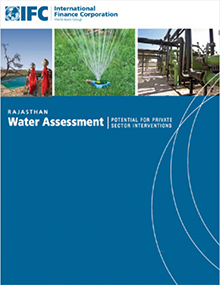 | RAJASTHAN WATER ASSESSMENT: POTENTIAL FOR PRIVATE SECTOR INTERVENTIONS Author(s): Hooda | Country: India Provides an in-depth and comprehensive overview of the challenges of drinking water supply, water quality, and agriculture-water in Rajasthan with a focus on potential private sector engagements. |
| See All Publications on World Bank Water in SOUTH ASIA→ |
See All World Bank Publications on Water→
